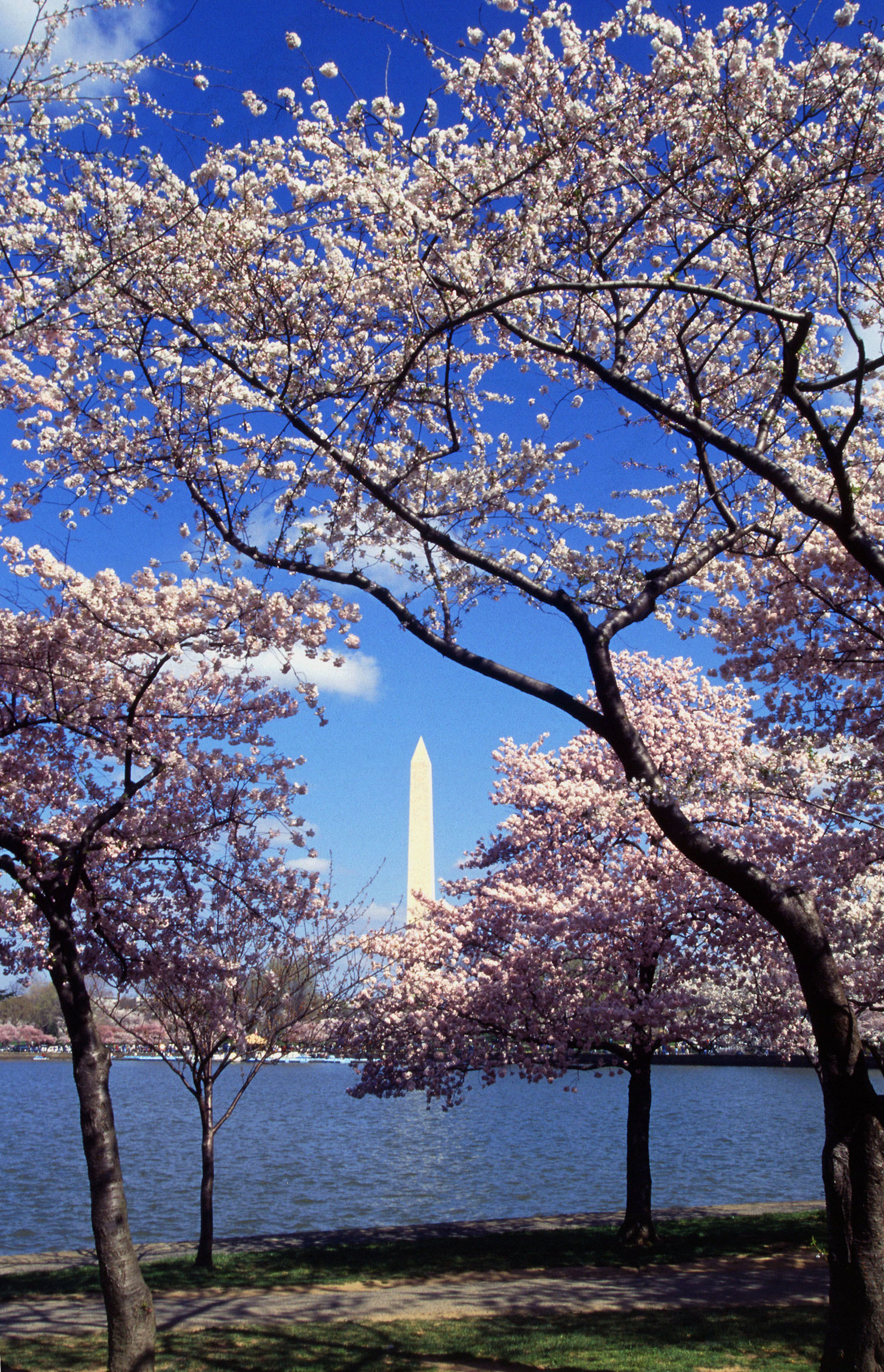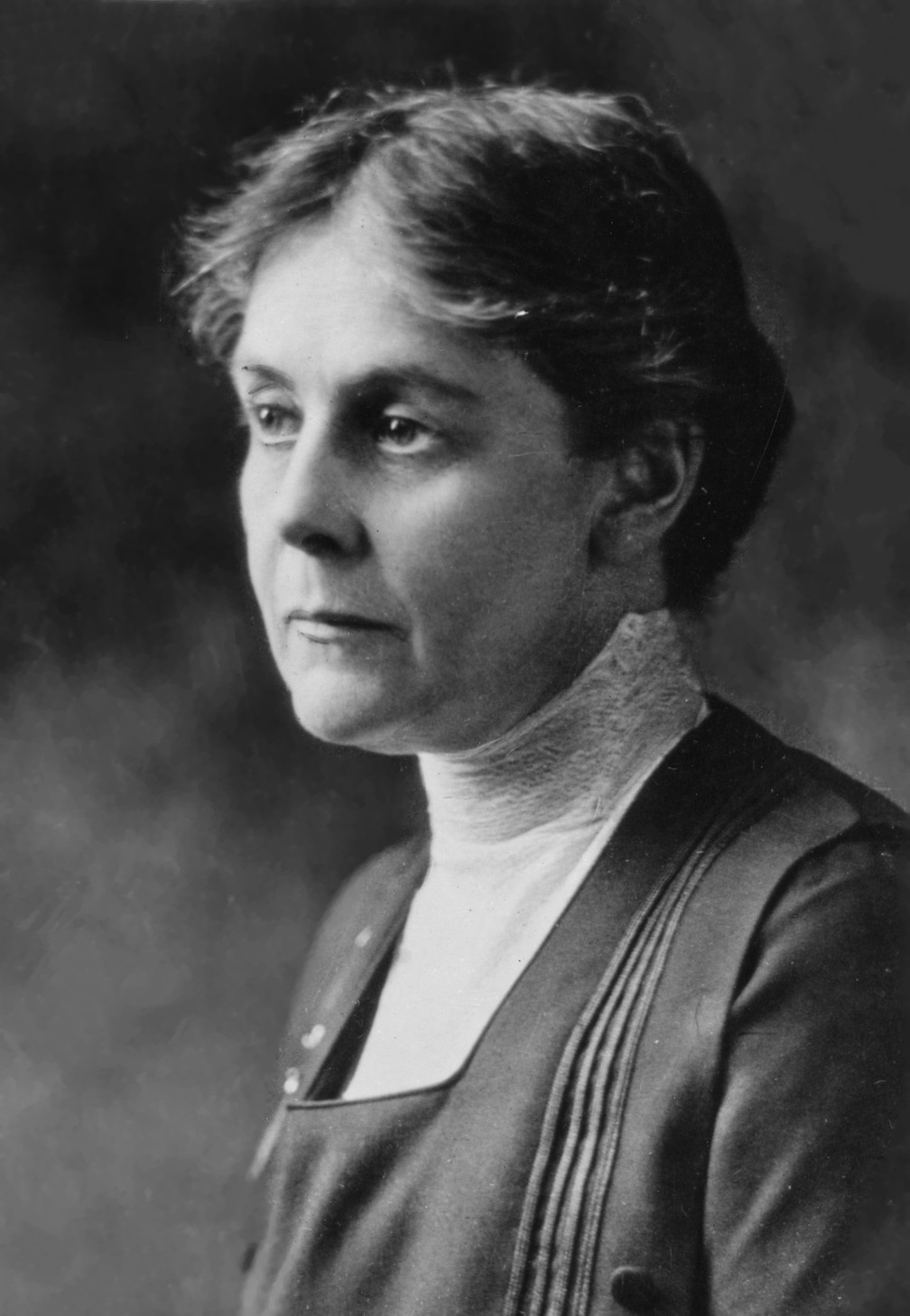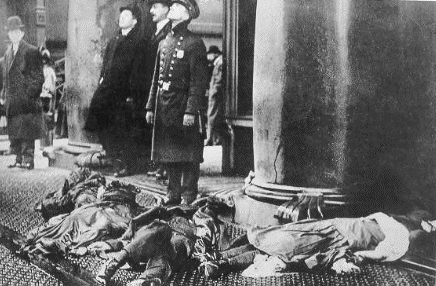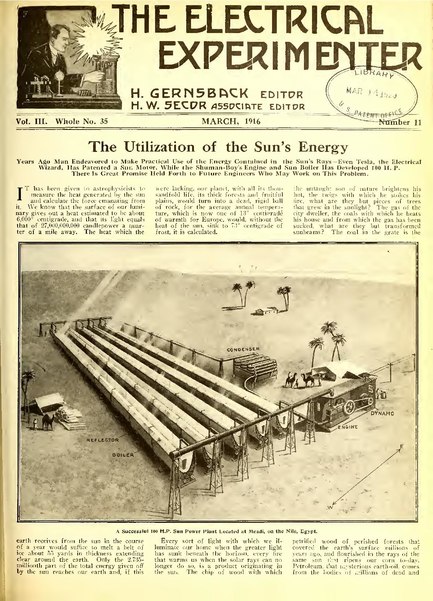 1910 — Japan presents 2,000 ornamental cherry trees to the city of Washington DC., but they are burned on the Washington monument grounds due to pests and diseases. On February 14, 1912, another 3,020 cherry trees of 12 varieties were shipped from Yokohama on board the S.S. Awa Maru, bound for Seattle. Upon arrival, they were transferred to insulated freight cars for the shipment to Washington. Planting begins March 28, 1912. The trees survived short-sighted attempts to chop them down in the 1940s and have continued to surround the tidal basin and grace downtown Washington DC.
1910 — Japan presents 2,000 ornamental cherry trees to the city of Washington DC., but they are burned on the Washington monument grounds due to pests and diseases. On February 14, 1912, another 3,020 cherry trees of 12 varieties were shipped from Yokohama on board the S.S. Awa Maru, bound for Seattle. Upon arrival, they were transferred to insulated freight cars for the shipment to Washington. Planting begins March 28, 1912. The trees survived short-sighted attempts to chop them down in the 1940s and have continued to surround the tidal basin and grace downtown Washington DC.
1910, June 11 — Jacques Cousteau born. The French oceanographer, inventor, explorer and environmental activist helped people around the world understand that a threat to the oceans was a threat to all life on earth.
1910 — First National Conference on Industrial Diseases held in Chicago.
1910 — Bureau of Labor’s study of “phossy jaw” (a disease of workers in the white phosphorous match industry) is a topic of concern. By 1912, a federal tax will price white phosphorous out of the market and the Diamond Match Co. will release its patent on a safer substitute for white phosphorous (Corn, 1992).
1910 — May 16 — The U.S. Bureau of Mines is created to deal with mine safety. The bureau would be disbanded by Congress in 1995.
 1910 — Alice Hamilton begins investigation of dangerous trades for Illinois governor’s commission. By 1912 the investigation will be expanded at the request of the US Department of Labor.
1910 — Alice Hamilton begins investigation of dangerous trades for Illinois governor’s commission. By 1912 the investigation will be expanded at the request of the US Department of Labor.
1910 — US Bureau of Labor issues a list of industrial poisons.
1910 — Insecticide Act mandates that pesticides be effective if they are to be sold. Administered by USDA, become FIFRA in 1947, EPA given oversight in 1972.
1911, March 1 — Weeks Act creates authority to purchase lands for National Forests, run by USDA’s Forest Service. Named for US Rep. John W. Weeks, the bill is an example of a belated federal response to enormous forest management problems, especially in the White Mountains of New Hampshire and in the Rocky Mountains in the Pacific Northwest region.
 1911, March 25 — Triangle Shirtwaist Fire breaks out in New York’s garment district killing 146 young immigrant workers. The incident is long remembered “because it highlights the inhumane working conditions to which industrial workers can be subjected,” according to a Cornell University memorial web site.
1911, March 25 — Triangle Shirtwaist Fire breaks out in New York’s garment district killing 146 young immigrant workers. The incident is long remembered “because it highlights the inhumane working conditions to which industrial workers can be subjected,” according to a Cornell University memorial web site.
1911 — Wisconsin becomes first state to establish a workers compensation program. (Corn, 1992). Others, including New York, quickly follow.
1911 — New York workers compensation act struck down by New York courts in Ives v. South Buffalo Railway Co. The judges argued that imposing strict liability on the railroad would deprive it of property without due process. Taking the workers side against conservative judges, Teddy Roosevelt says:
“It is not that the judges are corrupt, but that they are absolutely reactionary, and their decisions … have been such as almost to bar the path to industrial, economic and social reform. By such decisions they add immensely to the strength of the Socialist Party, they perpetuate misery, they increase unrest and discontent.” (quoted by Gersuny, 1981).
1911 — Preparing a report about the 1909 Glascow incidents, Dr. Harold Antoine Des Voeux coins term “smog” as a contraction for smoke-fog which he proposes at the Smoke Coal Abatement Society meeting in Manchester, England.
1912 — March — Popular Mechanics publishes “Remarkable Weather of 1911: The Effect of Combustion of Coal on the Climate: What Scientists Predict,” by Francis Molena, p. 339. “Since burning coal produces carbon dioxide, it may be inquired whether the enormous use of that fuel in modern times may not be an important factor in filling the atmosphere with this substance and consequently in indirectly raising the temperature of the earth.”
1912, April 30 — Thanhauser films releases The Cry of the Children depicting the harsh life of mill workers and the need for social reform. The film is based on Elizabeth Barrett Browning’s August 1843 poem of that name. Along with Lewis Hine’s photos of children laboring in the mills, Thanhauser films spurred calls for social justice and public health reform.
1912 — July 1 — David Brower born in Berkeley, California. President of the Sierra Club and founded of Friends of the Earth and Earth Island Institute, Bower is remembers as an uncompromising environmental activist in the John Muir tradition.
1912 — Bureau of Mines begins first smoke control study.
1912 — Frank Shuman’s Sun Power Co. builds a massive solar irrigation pump in the Egyptian desert for the British government in 1912. The 55 horsepower plant cost $8,200, or about $150 per hp, but was economically viable in a remote location like Egypt. Shuman was hailed as a success in Europe and signed a $200,000 contract with the Germans to build a plant in S.W. Africa. But WWI intervened and the plant was never built. (Butti)
1912 — Federal Water and Sanitation Investigation Station established in Cincinnati.
1912 — National Waterways Commission report recommends waterway improvements.
1912 — National Audubon Society begins campaign to boycott hat makers using endangered tropical bird feathers. One magazine article about the campaign is entitled “Millinery Murder.” (Millinery is a somewhat dated term for ladies hats).
1913 — Psychological Aspects of the Problem of Atmospheric Smoke Pollution by J.E. Wallin is published as “Smoke Investigation No. 3” by the University of Pittsburgh. “The deleterious effects on the human system from inhalation of smoke-polluted air, which contains not only acrid and irritating solids, but a certain amount of deadly poisons, should be obvious …”
1913 — U.S.-Canada boundary pollution commission established. Following an initial report, Congress considered a bill to prevent dumping of sewage into the Great Lakes and its tributaries, but the Public Health Service objects on the basis that the bill would be enforced by localities with questionable jurisdiction. Fishermen have already gutted key provisions of a the treaty in 1906. The greatly weakened boundary commission can do little more than observe as conditions deteriorate.
1913 –March 3 — U.S. Department of Labor established to promote the welfare of wage earners and to improve working conditions. The idea for a department had been building since the 1860s.
1913 — National council for Industrial Safety (now called the National Safety Council) is established.
1913 — to regulate hunting runs into controversy; spring hunting and marketing of hunted birds prohibited; treaty with Canada in 1918 solidifies regulations. Act also prohibits importation of wild bird feathers for women’s fashion into the U.S., ending “millinery murder.”
1913 — William T. Hornaday, head of New York Zoological Society, writes Our Vanishing Wildlife, Its Extermination and Preservation. By 1914, he helps establish the Permanent Wildlife Protection Fund with grants from Andrew Carnegie, Henry Ford and George Eastman.
1913 — Hetch Hetchy dam construction in Yosemite National Park approved by Congress — a major defeat for John Muir, who dies on Christmas Eve the next year. The debate over Hetch-Hetchy continues a centeury later. See the SF Chronicle and the Sacramento Bee articles from the spring of 2012.
1913 — March 4 —Migratory Bird Act, also called the Weeks-McLean Act, becomes effective after being passed by Congress and signed into law, but is soon challenged on Constitutional grounds. It was designed to stop commercial market hunting and the illegal shipment of migratory birds from one state to another.
All wild geese, wild swans, brant, wild ducks, snipe, plover, woodcock, rail, wild pigeons, and all other migratory game and insectivorous birds which in their northern and southern migrations pass through or do not remain permanently the entire year within the borders of any State or Territory, shall hereafter be deemed to be within the custody and protection of the Government of the United States, and shall not be destroyed or taken contrary to regulations hereinafter provided therefor.
Weeks-McLean was replaced by the 1918 Migratory Bird Treaty Act between the US and Canada, which was also challenged on Constitutional grounds in Missouri v Holland. The Supreme Court ruled that the federal government can regulate the taking of game. This helps set a foundation for the Endangered Species Act and other environmental laws, and adds to the growing body of law setting aside concerns about the supremacy of federal law over state laws.
1913, November — Synthetic ammonia for fertilizer, chemicals and explosives is first synthesized on an industrial scale by BASF in Germany following a process developed by Fritz Haber.
1914 — April 20 — Ludlow massacre — Colorado National Guard troops, acting on behalf of Standard Oil Company, open fire on a tent encampment of striking mine workers, killing 19 people (mostly women and children). Also see this wikipedia article.
1914 — Corps of Engineers, Bureau of Mines, Public Health Service begin pollution surveys of streams and harbors. Reports filed over the next eight years show an accumulation of heavy damage from oil dumping, mine runoff, untreated sewage and industrial waste.
1914 — Corps of Engineers also begins an extensive investigation of acid mine run-off in the Ohio River basin at the request of West Virginia Congressman Benjamin Rosenbloom. Some 250 public officials and industry executives are consulted about their use of water and the remedies for acid deposition from working or abandoned mines. One of the problems with increasing stream acidity was the great additional expense in filtering drinking water and corrosion and scaling of city water pipes, which tended to be expensive for cities and industry. An editorial in the Pittsburgh Dispatch said that the state government should consider financial losses from pollution:
“The mistake made by most of those who have tried to obtain relief from stream pollution was that instead of emphasizing these losses they harped on the killing of the fish and the interference with recreation. The Legislature has never been much impressed with these pleas. Owners of the mines and mills which have polluted the streams urged with good reason that it was more important that they be unhampered in their business than that the fishing should be good in Pennsylvania Rivers. This industrial loss, however… is a different matter.”
 1914 — Sept. 1 — “Martha,” the last captive passenger pigeon, dies in the Cincinnati zoo.
1914 — Sept. 1 — “Martha,” the last captive passenger pigeon, dies in the Cincinnati zoo.
They were called passenger pigeons because they flew in a mass like passengers from one spot to another. They did not migrate as other birds do from one locale to another as the seasons change, but moved north to south and back across the continent from roost to roost, feasting on the “mast,” or seeds, acorns, hackberries, hempseed, huckleberries, beech nuts, hemlock seeds, pine seeds, worms, caterpillars, Indian corn, rye, and wheat in the trees, bushes, forest floor and — hastening their demise — farmers’ fields. They could strip a field of wheat within a few hours.
They moved across the Great Lakes and Midwest north as far as Hudson’s Bay and south to Texas and northern Mexico in staggering numbers, millions upon millions of birds in deafening and defecating flocks roaring over the forests, farms and Great Lakes. It has been estimated that at one time, one out of three wild birds in America was a passenger pigeon; between three to five billion of them flew in endless undulating flocks in the skies. Chief Pokagon wrote in 1895 for another outdoors magazine, Chautuaguan: “When a young man I have stood for hours admiring the movements of these birds … ever varying in hue; and as the mighty stream, sweeping on at sixty miles an hour, reached some deep valley, it would pour its living mass headlong down hundreds of feet, sounding as though a whirlwind was abroad in the land. “The sound of the birds was a mingling of sleigh bells, mixed with the rumbling of an approaching storm. While I gazed in wonder and astonishment, I beheld moving toward me in an unbroken front, millions of pigeons … they passed like a cloud through the branches of the high trees, through the underbrush and over the ground apparently overturning every leaf. Statue-like I stood half concealed by cedar boughs. They fluttered all about me, lighting on my head and shoulders; gently I caught two in my hands and carefully concealed them under my blanket.” — Bill Loomis, Slaughtered to extinction: Passenger pigeons in Michigan, Detroit News, March 18, 2012. =========
“There was never a sight in all the world we humans have known to match the splendor of the passenger pigeon in its flights. Vivid in their red, gold, and purple plumage, with long tails and streamlined bodies, they were grace incarnate as they sped by overhead in veritable torrents of birds, wheeling and turing, rising and diving with a thunderous flapping of their wings, as if the whole were an avian embodiment of the aurora borealis. Perhaps the great herds of wildlife moving over the Serengeti may inspire a similar feeling of awe. Numbering, like the chestnut, about four billion individuals in the early 19th century, the passenger pigeon may have been the most successful social bird ever to have lived. Completely dominating the skies within its range, it may have been as much as 40% of the bird population of the continent, the most numerous higher animal species on earth at the time. 6 Intensely gregarious, it massed in numbers beyond comprehension. J.J. Audubon describes a flock that passed him over Kentucky. He began tallying groups as they passed overhead but soon gave up as the sky was darkened with their vast number for more than three days. Hundreds of millions of birds in each mass may have flown together. The largest roosting of passenger pigeons ever recorded was seen in Wisconsin in 1871: it spread over 850 square miles, and was estimate at 136 million, over 250 birds per acre. This, however, was after their numbers had already begun to decline significantlyPeter Bane, “Keystones and Cops: An Eco-Mystery Thriller,” The Permaculture Activist May 2003, #50
It was the moment that humanity learned we had the awesome power to erase an entire species off the face of the Earth in the scientific equivalent of a blink of an eye: The passenger pigeon went from billions of birds to extinct before our very eyes. It was one bird’s death after many. But a century ago, Martha, a red-eyed, grey and brown bird famous as the last surviving passenger pigeon, keeled over, marking an extinction that shook science and the public. Seth Borenstein, Associated Press, June 17, 2014
1914, Dec. 24 — John Muir dies. How is his legacy seen today? The Los Angeles Times has one take.
1915 — California legislature authorizes $10,000 to start planning and construction of the John Muir Trail.
1915 — Dinosaur National Monument established in Utah.
1915, April 15 — Garrett Hardin born.
1916 — National Park Service created. President Woodrow Wilson created the national park system with the Organic Act of 1916 designed to “conserve the scenery and the natural and historic objects [and] leave them unimpaired for the enjoyment of future generations.” According to the Environmental News Network, there are now 77.5 million acres of land preserved in the Park system. One inspiration that helped the Organic Act pass Congress was a motion picture of proposed park areas by photographer Herford Cowling.
(Note: Teddy Roosevelt is often wrongly cited as the father of the park system, but his contribution was the National Wildlife Refuge System, begun in 1903. During his presidency, over 230 million acres were placed under federal protection. But the Park Service began in 1916.)
1916 — Margaret Sanger opens first legal birth control clinic after struggling with American prudishness and “Comstockery” over public health issues.
1916 — GM and United Motors buy Charles Kettering’s DELCO, leaving him free to begin experiments with preventing engine knock that lead to leaded gasoline. By 1919, Kettering’s research group will become the nucleus of the General Motors research division, and the engine knock experiments will lead to leaded gasoline by 1921.
1917 — Corps of Engineers removed lock gates in old canal in Virginia’s Dismal Swamp, allowing salt water into North Carolina’s Currituck Sound, a major waterfowl estuary. After a fight with the Corps of Engineers, environmental activists finally persuade Congress in 1930 to restore the gates and preserve the sound.
1917 — Mount McKinley National Park established in Alaska.
1917 — Naturalist Charlie Kellog builds a camper out of a felled redwood tree and starts a campaign to save the redwoods. He was, says environment writer Jim Motavalli, a vaudeville star and an early conservationist who called attention to our vanishing forests with a 3,000-year-old redwood on wheels.
1918 — Save the Redwoods League founded.
1918 — Migratory Bird Treaty with Canada restricts hunting of geese and other migratory birds.
1918 — Scientific American reports alcohol-gasoline anti-knock blend is “universally” expected to be the fuel of the future. Seven years later, in Public Health Service hearings, General Motors and Standard Oil spokesmen will claim that there are no alternatives to leaded gasoline as an anti-knock additive.
1918 — Russian revolutionary Leon Trotsky says: “The proper goal of communism is the domination of nature by technology and the domination of technology by planning, so that raw materials of nature will yield to mankind all that it needs and more besides.” This philosophy will lead to environmental disasters in decades ahead.
1919 — London General Omnibus Co. experiments prove effectiveness of ethanol as antiknock (octane booster).
1919 — International Labour Organisation (ILO) is founded. Protection of workers against sickness, disease and injury from their jobs one of its major goals.
1919 — Jan. 15 — Twenty one people die in Boston following the rupture of a 2.5 million gallon tank of molasses.


